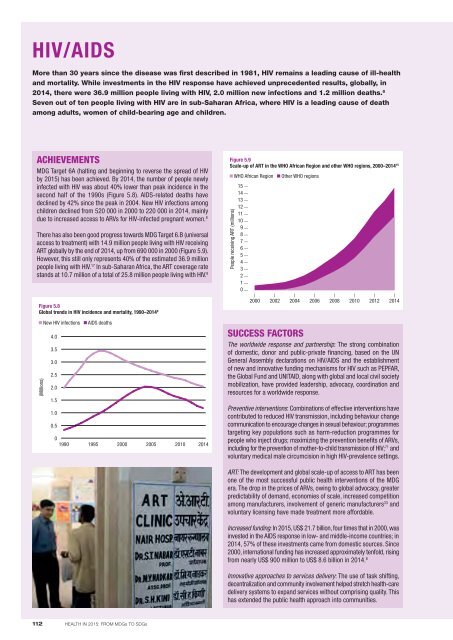Create successful ePaper yourself
Turn your PDF publications into a flip-book with our unique Google optimized e-Paper software.
HIV/AIDS<br />
More than 30 years since the disease was first described in 1981, HIV remains a leading cause of ill-health<br />
and mortality. While investments in the HIV response have achieved unprecedented results, globally, in<br />
2014, there were 36.9 million people living with HIV, 2.0 million new infections and 1.2 million deaths. 8<br />
Seven out of ten people living with HIV are in sub-Saharan Africa, where HIV is a leading cause of death<br />
among adults, women of child-bearing age and children.<br />
ACHIEVEMENTS<br />
MDG Target 6A (halting and beginning <strong>to</strong> reverse the spread of HIV<br />
by 2015) has been achieved. By 2014, the number of people newly<br />
infected with HIV was about 40% lower than peak incidence in the<br />
second half of the 1990s (Figure 5.8). AIDS-related deaths have<br />
declined by 42% since the peak in 2004. New HIV infections among<br />
children declined <strong>from</strong> 520 000 in 2000 <strong>to</strong> 220 000 in 2014, mainly<br />
due <strong>to</strong> increased access <strong>to</strong> ARVs for HIV-infected pregnant women. 8<br />
There has also been good progress <strong>to</strong>wards MDG Target 6.B (universal<br />
access <strong>to</strong> treatment) with 14.9 million people living with HIV receiving<br />
ART globally by the end of 2014, up <strong>from</strong> 690 000 in 2000 (Figure 5.9).<br />
However, this still only represents 40% of the estimated 36.9 million<br />
people living with HIV. 17 In sub-Saharan Africa, the ART coverage rate<br />
stands at 10.7 million of a <strong>to</strong>tal of 25.8 million people living with HIV. 8<br />
Figure 5.8<br />
Global trends in HIV incidence and mortality, 1990–2014 8<br />
(Millions)<br />
New HIV infections<br />
4.0<br />
3.5<br />
3.0<br />
2.5<br />
2.0<br />
1.5<br />
1.0<br />
0.5<br />
AIDS deaths<br />
0<br />
1990 1995 2000 2005 2010 2014<br />
Figure 5.9<br />
Scale-up of ART in the WHO African Region and other WHO regions, 2000–2014 15<br />
People receiving ART (millions)<br />
WHO African Region<br />
15 —<br />
14 —<br />
13 —<br />
12 —<br />
11 —<br />
10 —<br />
9 —<br />
8 —<br />
7 —<br />
6 —<br />
5 —<br />
4 —<br />
3 —<br />
2 —<br />
1 —<br />
0 —<br />
l<br />
2000<br />
l<br />
2002<br />
Other WHO regions<br />
l<br />
2004<br />
l<br />
2006<br />
l<br />
2008<br />
l<br />
2010<br />
l<br />
2012<br />
l<br />
2014<br />
SUCCESS FACTORS<br />
The worldwide response and partnership: The strong combination<br />
of domestic, donor and public-private financing, based on the UN<br />
General Assembly declarations on HIV/AIDS and the establishment<br />
of new and innovative funding mechanisms for HIV such as PEPFAR,<br />
the Global Fund and UNITAID, along with global and local civil society<br />
mobilization, have provided leadership, advocacy, coordination and<br />
resources for a worldwide response.<br />
Preventive interventions: Combinations of effective interventions have<br />
contributed <strong>to</strong> reduced HIV transmission, including behaviour change<br />
communication <strong>to</strong> encourage changes in sexual behaviour; programmes<br />
targeting key populations such as harm-reduction programmes for<br />
people who inject drugs; maximizing the prevention benefits of ARVs,<br />
including for the prevention of mother-<strong>to</strong>-child transmission of HIV; 71 and<br />
voluntary medical male circumcision in high HIV-prevalence settings.<br />
ART: The development and global scale-up of access <strong>to</strong> ART has been<br />
one of the most successful public health interventions of the MDG<br />
era. The drop in the prices of ARVs, owing <strong>to</strong> global advocacy, greater<br />
predictability of demand, economies of scale, increased competition<br />
among manufacturers, involvement of generic manufacturers 33 and<br />
voluntary licensing have made treatment more affordable.<br />
Increased funding: In 2015, US$ 21.7 billion, four times that in 2000, was<br />
invested in the AIDS response in low- and middle-income countries; in<br />
2014, 57% of these investments came <strong>from</strong> domestic sources. Since<br />
2000, international funding has increased approximately tenfold, rising<br />
<strong>from</strong> nearly US$ 900 million <strong>to</strong> US$ 8.6 billion in 2014. 8<br />
Innovative approaches <strong>to</strong> services delivery: The use of task shifting,<br />
decentralization and community involvement helped stretch health-care<br />
delivery systems <strong>to</strong> expand services without comprising quality. This<br />
has extended the public health approach in<strong>to</strong> communities.<br />
112 HEALTH IN 2015: FROM MDGs TO SDGs


